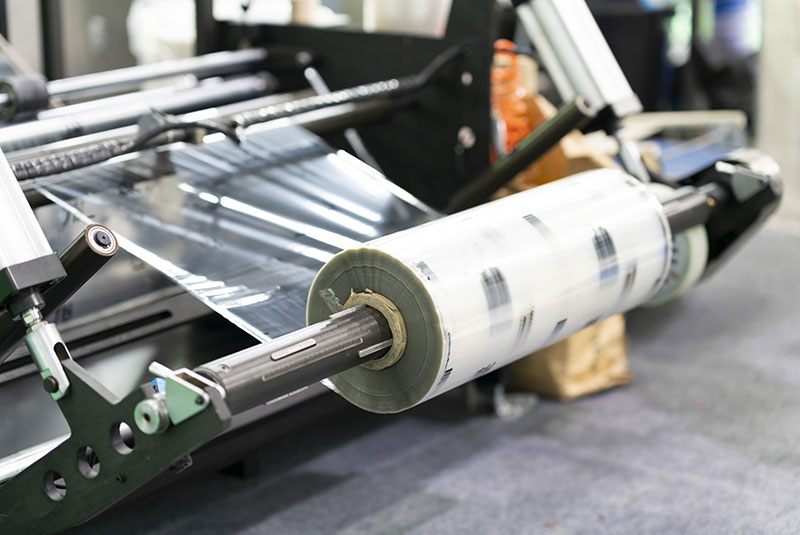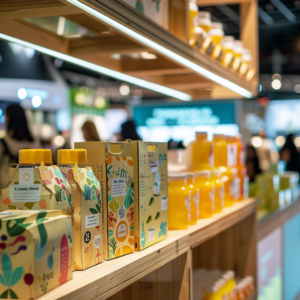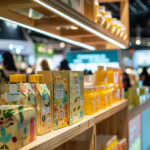Shrink film, also known as shrink wrap, is a material made up of polymer plastic film. When heat is applied, it shrinks tightly over whatever it is covering. Heat can be applied with a handheld heat gun, or the product and film can pass through heat tunnel on a conveyor. The film’s interaction with the machinery is a key part in picking the correct type of film. The most important aspect of shrink film is the width of the roll. A roll could have two different linear lengths, but still have the same price if the width is the same.
Shrink film is available in various types, clarities, thicknesses, shrink ratios, and strengths, which can be employed alone or together to create the precise kind of layering and protection for your product. Over time, these options and constructions have broadened to accommodate specific requirements for sealability, optics, toughness, slip, temperature, force, and memory.
The Difference Between Shrink Film and Stretch Film
Stretch film and shrink film are often confused because they look very similar, and both can be made of polyethylene (PET). However, both perform quite differently from each other.
When PE is used in a shrink film application, it is loosely placed over a single item or multiple items around which it will shrink when heat is applied, creating a tight, tamper-resistant seal of protection.
When PE is used in stretch applications, it is formulated differently to be able for it to stretch around items. The elastic memory of the film, coupled with its ability to cling to itself, keeps a tight layer of protection around the items. Stretch film is generally used to palletize or unitize multiple items on a pallet, which keeps them from shifting during shipment. Stretch film usually stretches about 100-300%, compared to shrink film, which typically only stretches to around 50-75% before breakage occurs.
The Advantages of Using Shrink Film
The advantages of using shrink film in your packaging process are numerous. Shrink film’s flexibility, strength, visual capabilities, and recyclability make it the ideal option for many types of products and applications. Here are some of its notable benefits:
Protection: Shrink film’s durability provides it with the ability to preserve the contents of your packaging. If you’re packaging thousands of items per day and are using automatic or semi-automatic wrapping machines, cross-linked shrink film will help reduce product damage and packaging waste. Also, shrink film helps increase the shelf-life of perishable items and can conceal the smells of packaging contents.
Sustainability: One of the most significant advantages of PE shrink films is that it’s recyclable. As sustainability increases in importance for consumer packaged goods businesses of all sizes, it’s becoming more critical than ever to adopt packaging materials that meet sustainability standards. Additionally, polyolefin (POF) shrink film doesn’t release harmful vapors during the heat-sealing process, as PVC does.
Presentation: POF shrink film can be customized to the product you’re packaging. You’ll find formulations of shrink film that are perfect for packaging meats and foods for added versatility. These formulations include barriers to reduce fog or moisture-vapor transmission.
Marketability: Unlike a solid box, shrink film can be used to bundle a tray and clearly display the contents of the tray being bundled. It allows the end user to see exactly what is inside without having to guess. Shrink film can also be printed on so graphics can display all sorts of communication to the customer to understand and draw attention to the product.
Cost Reduction: By taking advantage of shrink film’s durability and strength, many brands have removed corrugated packaging from their multi-pack products altogether. Heavier products can be securely wrapped in shrink film without the need for a corrugated tray, and lightweight items can be packaged in a poly bag. This helps reduce the cost of packaging and minimizes your shelf footprint, which opens up more space in your facility.
Common Shrink Wrap Terms
Centerfold Shrink Film – Film that has been folded in half lengthways to make wrapping easier and quicker.
Crow’s Feet – Wrinkles diverging out from a finished package’s corners
Dog Ears – Triangular projections of unshrunk film at the corners of complete packages. This is common in packages wrapped with PVC shrink wrap.
Gauge – a measurement used to describe film thickness.
Impulse Sealer – A sealer using a heating element that is pulsed with voltage during the sealing process. The heat from the sealer mends polymer materials together.
L-Bar Sealer – A sealer where the sealing surface is in the shape of a backward “L.” This is a universal sealer for people that want to seal faster than using an impulse sealer.
Lap Seal – Making a seal using two layers of shrink film lapped over each other.
Machine Direction – The direction the film is manufactured and move through the sealing equipment.
Memory – The ability of a shrink film to maintain characteristics after sealing
Optics – The visual properties of a shrink or stretch film
Polyolefin – A polymer produced from a simple olefin as a monomer. Shrink film made from this is commonly referred to as POF shrink film.
PVC – Polyvinyl Chloride, a thermoplastic polymer that is the third most-produced plastic in the world. PVC shrink film is a universal shrink wrap that is used for many different applications.
Shrink Tunnel – Equipment that uses a chamber to produce heat with a continuous conveyor running through the chamber.
Tear Resistance – The ability of a film to resist tear with forced exertion on the film. Using a shrink film with a high tear resistance is important when wrapping heavy products or products with sharp edges.
Given the flexibility and durability of shrink film, many companies employ this option to package their products. Contact Korpack today if you’re interested in learning more about what shrink film is and the benefits it can provide your company.








